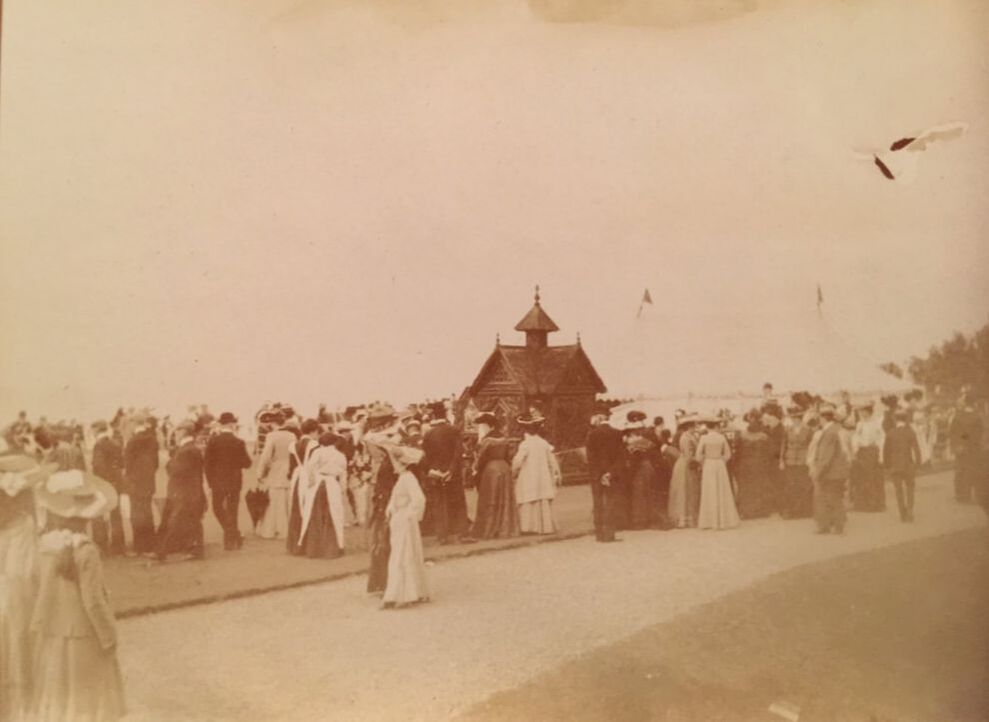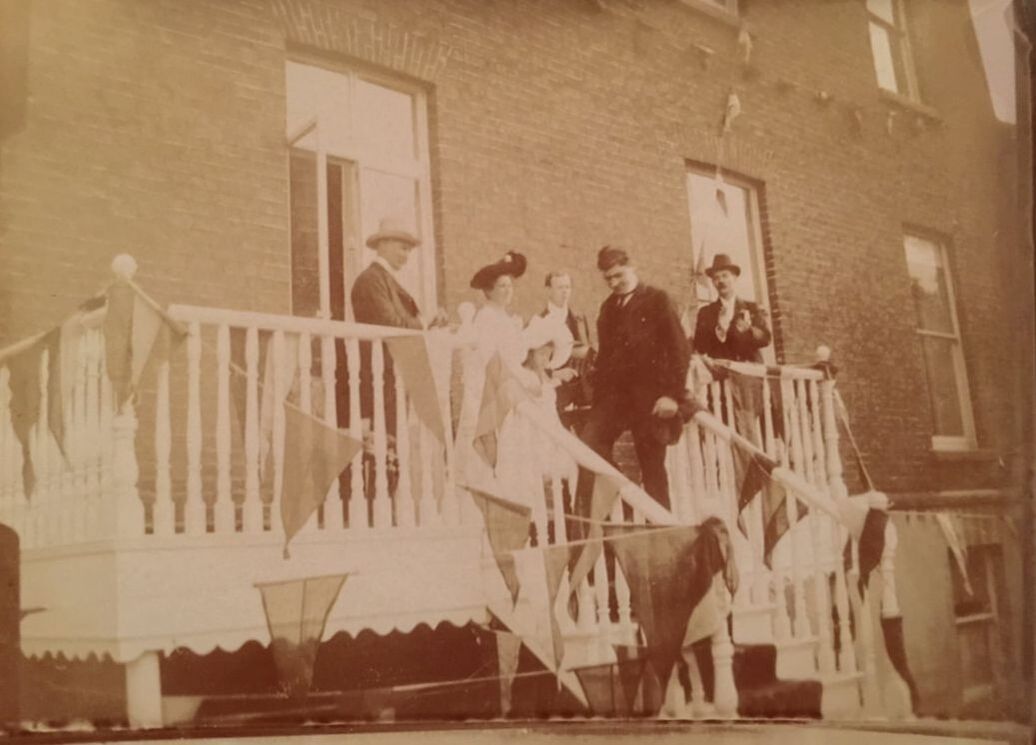The Blackrock House Fête of 1904
In early 1902 a new Methodist Church was proposed for Kingstown on the site of the old church and manse on Northumberland. In December 1902 the new Church was planned at an estimated cost of £5000 at a social meeting and by March 1903 a scheme was in place and a committee elected. They had a grant of £1000 by May from the Wesleyan 20th Century fund (this was a fund established in 1898 also known as the One Million Guinea Fund where no one could donate more the 1 Guinea). They needed to raise a further 4K and the several McCormick families in the area pledged £1050 of the total of £1850 promised at the meeting. The demolishment of the old edifice went ahead and the building salvage was put up for sale including doors, windows and slates. The seven foundation stones were laid on 31 Oct 1903 by seven ladies including Mrs W O McCormick and Miss K McCormick. By the end of May 1904, they had raised 3K and they needed to put a fund raiser in place to raise the balance. A Garden Fête was the chosen form and T C McCormick offered the use of his grounds at Blackrock House to the Rev J M Alley and the Executive Committee. These grounds were ideally suited for such an event given the private harbour, the beautiful terraced walks and all its nooks and dells. It was a very ambitious project given the limited timeframe.
Titania was the name selected for this grand open-air fête and aquatic sports event to be held at Blackrock House. It took place on Friday and Saturday, 17th and 18th June 1904 and it was under the patronage of His Excellency the Lord Lieutenant, William Humble Ward, Earl of Dudley. The name is possibly a nod to Titania the Queen of the Fairies from Shakespeare’s Midsummer’s Night’s dream which had played in The Theatre Royal in March of that year, besides the fact that it was being held so close to Midsummer. The Hon Sir Horace Plunkett, introduced by Maurice Dockrell, JP opened the Fête on 1:30pm on the17th and Lieutenant Colonel Latchford of the RAMC reopened it at 1:30 on the 18th, presided over by J H North. Entrance was 1s for adults and 6d for children, the cost dropped to 6d after 6pm. It closed each evening at 10pm. The countless attractions included bicycle polo, barrel races, cycling gymkhana, golf putting, motor and horse rides, water polo, a duck hunt, swimming races, shooting competitions with prizes for the winners. There were also two steam launches and boats in the harbour offering trips into the bay. There was a firework display each evening and the band and pipers from the Seaforth Highlanders, by permission of Colonel Sidney Bellingham Jameson of Montrose and his officers, were in attendance on both days. The largest marquee ever seen in Dublin was erected to house the luncheons, teas and a flower show. The grounds were bedecked with banners and bunting and numerous tents and stalls were dotted around the gardens. Mrs Samuel McCormick was on the flower stall and Mrs William McCormick was on refreshments. The opening ceremony on the Friday was beset with showers and it rained so heavily in the afternoon that people were deterred from attending. The weather was slightly improved by Saturday. TC McCormick arranged a garden party at Blackrock House in July 1904 to thank the workers involved in the organisation of the fête and all were issued with an invitation to attend.
The new Methodist church built in the early English or Gothic revival style was of cut stone. The design included a tower and spire but this was not a planned part of the initial build, however the foundations were capable of supporting same if they wished to build them in the future. The architect was George F Beckett, the contactors were J & P Good of Dublin and the church was capable of seating 250 people. Steam heating was installed by Messrs Maguire and Gatchell, the cost of new organ at £300 was offset by a donation of £150 from Andrew Carnegie, the Sottish-American industrialist and philanthropist. On the evening of 7 Oct 1904, the new Church was dedicated, it had cost £5,300 and they still needed to raise 1K, so it appears that the fête didn’t raise the required amount. However over 500 people attended the dedication service and it was announced after the service that £537 had been received towards liquidating the debt, so some of this may have come from the fete. Mrs McCormick was presented with a silver key.
© June Bow & Karen Poff - April 2023
In early 1902 a new Methodist Church was proposed for Kingstown on the site of the old church and manse on Northumberland. In December 1902 the new Church was planned at an estimated cost of £5000 at a social meeting and by March 1903 a scheme was in place and a committee elected. They had a grant of £1000 by May from the Wesleyan 20th Century fund (this was a fund established in 1898 also known as the One Million Guinea Fund where no one could donate more the 1 Guinea). They needed to raise a further 4K and the several McCormick families in the area pledged £1050 of the total of £1850 promised at the meeting. The demolishment of the old edifice went ahead and the building salvage was put up for sale including doors, windows and slates. The seven foundation stones were laid on 31 Oct 1903 by seven ladies including Mrs W O McCormick and Miss K McCormick. By the end of May 1904, they had raised 3K and they needed to put a fund raiser in place to raise the balance. A Garden Fête was the chosen form and T C McCormick offered the use of his grounds at Blackrock House to the Rev J M Alley and the Executive Committee. These grounds were ideally suited for such an event given the private harbour, the beautiful terraced walks and all its nooks and dells. It was a very ambitious project given the limited timeframe.
Titania was the name selected for this grand open-air fête and aquatic sports event to be held at Blackrock House. It took place on Friday and Saturday, 17th and 18th June 1904 and it was under the patronage of His Excellency the Lord Lieutenant, William Humble Ward, Earl of Dudley. The name is possibly a nod to Titania the Queen of the Fairies from Shakespeare’s Midsummer’s Night’s dream which had played in The Theatre Royal in March of that year, besides the fact that it was being held so close to Midsummer. The Hon Sir Horace Plunkett, introduced by Maurice Dockrell, JP opened the Fête on 1:30pm on the17th and Lieutenant Colonel Latchford of the RAMC reopened it at 1:30 on the 18th, presided over by J H North. Entrance was 1s for adults and 6d for children, the cost dropped to 6d after 6pm. It closed each evening at 10pm. The countless attractions included bicycle polo, barrel races, cycling gymkhana, golf putting, motor and horse rides, water polo, a duck hunt, swimming races, shooting competitions with prizes for the winners. There were also two steam launches and boats in the harbour offering trips into the bay. There was a firework display each evening and the band and pipers from the Seaforth Highlanders, by permission of Colonel Sidney Bellingham Jameson of Montrose and his officers, were in attendance on both days. The largest marquee ever seen in Dublin was erected to house the luncheons, teas and a flower show. The grounds were bedecked with banners and bunting and numerous tents and stalls were dotted around the gardens. Mrs Samuel McCormick was on the flower stall and Mrs William McCormick was on refreshments. The opening ceremony on the Friday was beset with showers and it rained so heavily in the afternoon that people were deterred from attending. The weather was slightly improved by Saturday. TC McCormick arranged a garden party at Blackrock House in July 1904 to thank the workers involved in the organisation of the fête and all were issued with an invitation to attend.
The new Methodist church built in the early English or Gothic revival style was of cut stone. The design included a tower and spire but this was not a planned part of the initial build, however the foundations were capable of supporting same if they wished to build them in the future. The architect was George F Beckett, the contactors were J & P Good of Dublin and the church was capable of seating 250 people. Steam heating was installed by Messrs Maguire and Gatchell, the cost of new organ at £300 was offset by a donation of £150 from Andrew Carnegie, the Sottish-American industrialist and philanthropist. On the evening of 7 Oct 1904, the new Church was dedicated, it had cost £5,300 and they still needed to raise 1K, so it appears that the fête didn’t raise the required amount. However over 500 people attended the dedication service and it was announced after the service that £537 had been received towards liquidating the debt, so some of this may have come from the fete. Mrs McCormick was presented with a silver key.
© June Bow & Karen Poff - April 2023


